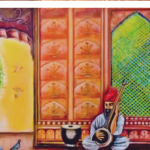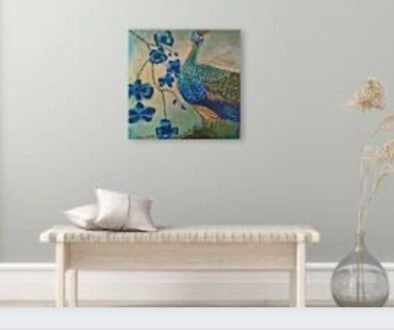Are Artists Born Or Made? Success Tips For The Self-Taught Artist.
Through formal training, artists are mentored and guided to improve and hone their creative skills. Via an art education, the artist gets an opportunity to explore and use various media, styles, and techniques, under the guidance of a teacher. When it comes to finding jobs and internships, having a degree in fine art is a great way to make you stand out and gives you a head-start over the self-taught artist.
While I have a great deal of respect for art grads, I believe like many others, that art is an energy that is fuelled by passion – the kind of passion that cannot be taught. I believe that art is a creative calling cant be taught.
#Indian paintings #Aesthetic paintings #Zen Artist Sabrina Gill
Shop these now at https://www.etsy.com/shop/RengeBySabrina and http://sabrinagill.in
I Am Seeking, I am Striving, I am In It With All My Heart…
The achievements of renowned masters like Van Gogh, Monet, the more recent M.F. Hussain, bear testimony to the fact that the lack of an art degree, does not mean a lack of talent. Vincent Van Gogh studied art briefly at the Antwerp Academy, but this had little influence on his approach to art. Some of the world’s best and most famous artists never had an art education.
A huge number of art aficionados, curators, collectors, gallerists and others from the world of art, believe that an art degree can curb spontaneity and prevent creative people from demonstrating the true depth of their talent – creativity cannot be hemmed in, structured, or taught – it has to be expressed. American Art historian Barbara Rose claims that educated artists, at times, produce art that looks “like homework.”
Unlike “homework art“ that follows the rules, art made by self-taught artists conveys a spontaneous, passionate, unbridled energy. The self-taught artist, through a process of experimentation, trial and error, adopts a completely different approach to art. Undefined by rules, the art a self-taught artist creates are expressions of passion – a passion that cannot be tamed.
Disciplined and focused, self-taught artists work well alone. They learn and pursue only what is essential to the art they wish to create. Creatively, they are able to think out of the box, and continually experiment and innovate to perfect their style of art.
There is great freedom to creating without instruction. If you don’t study art, your approach to art is entirely different. Everything comes from within you – which has its merits and demerits.
You could argue that an art degree is necessary for artists to learn the techniques of their craft and the greatest benefit of going to art school is that the system prepares you and directs you towards a job and an art career. On the other hand, finding career opportunities and openings are a struggle for the self-taught artist.
So are artists born or made? Success as an artist requires and combination of talent, perseverance and enterprise. With no formal training, what is the best route to take to grow and carve a niche for yourself artist? “Today you can learn almost anything yourself if you have the patience and tenacity”, says Ignasi Monreal, a self-taught artist. The internet has made it possible for artists to master the nitty-gritty of digital marketing and social media marketing to promote themselves. Here are some tips for self-taught artists to succeed.
- Motivation
Motivation is a prerequisite to success in any field. The motivation to be the best is what drives an artist to put in the hours and master the craft. Make every art session count and take your skills to the next level.
- Do the groundwork – research the market
The first step in selling your work is to conduct thorough market research. This preliminary groundwork work can help you plan and build the right website, create opportunities to further your art career and establish an identity as an artist.
My advice to newbies in the field of digital marketing is to pay an expert to build a strong website. Subsequently, driving traffic to your website and marketing your art is a job that you alone can do justice to.
- Build a strong online presence – showcase your work online.
As a self-taught artist, you control all aspects of your creativity and marketing strategies. The demand for your work depends on cultivating an inspiring persona— both, in person and online – build a website where you feature your body of work and chronicle your creative journey.
Performing in-depth research and following the steps listed below, will equip you with information and facts to identify and reach your target audience.
- Stay abreast of the competition
Explore the kind of art your competitors are creating by checking online and at art shows.
- Harness the power of Social media to market yourself and your work.
Set up a Facebook page, an Instagram and a Twitter handle and post your work regularly. Run social media adverts and create your social media target audience. This might seem daunting and overwhelming at first, but it is quite easy to educate yourself on social media marketing via Pinterest tutorials, YouTube videos and a host of online courses available on the subject. Learn the in’s and out’s of Search Engine Optimization (SEO) and drive traffic to your website by regularly posting SEO compliant blogs.
To sell your work, you also need to use your website to develop a presence on high-traffic platforms like Etsy. Along with talent and determination, you must smartly market yourself and your work. How well you execute and follow through with what you learn can help you create a standing for yourself in the art community. Here are links to tutorials, videos, websites that helped me understand the complexities of SEO, blogging, and social media marketing – https://pin.it/Ky4CnbP, https://pin.it/4iHS9Pi, https://pin.it/3ieNQot, https://pin.it/3CF6GiM, https://youtu.be/BXgYpJQlfuk. There are a lot of free courses on digital marketing, SEO, blogging that you could enroll in. Scour the pages of Google, YouTube, Pinterest and find those courses and develop your digital marketing skills.
- Beat the competition
Beat the competition by pricing your products lower than your competitors. Set a price your competitors can’t match.
- Be your own worst critic
It was easy to view your own work with rose-tinted glasses but in order to grow, you need to set very high standards for yourself.
Submit your work to competitions and galleries to get unbiased feedback.
- Expect nothing, but aim to be the best
It is important to be patient and enjoy the process of becoming an artist, without high expectations. It is important to have unbound optimism. This is what propels you to move forward. In fact you should certainly not achieve everything you desired when you embarked on your creative journey- if you have, you did not dream big enough.
- Connect with the art fraternity – stay current with art market trends.
For artists, hanging out at events like art shows, art inaugural events, art fairs keeps you in touch with art trends, art market trends, artists, buyers and helps you forge connections with potential buyers. Every interaction and experience with the art community builds your network, audience, and brand – never lose an opportunity to hob-nob with gallerists, curators and the likes. Attend workshop sessions conducted by artists who inspire you, get yourself mentored by your dream master artist and collaborate with fellow artists for group exhibitions, online shows, etc. Energy and passion are infectious so spend time with other artists to stay inspired.
Fall in love with the process of becoming the best artist you could ever be. The goal isn’t just getting there – it is also to have fun along the way. When you enjoy the process, your goal becomes a milestone, not a finishing line.T







